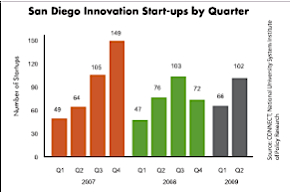 National Engineers Week (February 14 to 20) is
celebrated this week. You may not be aware but engineers are playing a
much larger role in your life than you think. Every single product that
you consume or use was conceived in the mind of an engineer, designed by
an engineer, and made by engineers. From the toothbrush you use to the
toilets you flush, everything we use has been created by engineers.
There are only about 1 million engineers in this country. This is a tiny
fraction of the 120 million+ workforce. And yet 80% of the income
growth in this country is directly related to engineering inventions and
innovations.
National Engineers Week (February 14 to 20) is
celebrated this week. You may not be aware but engineers are playing a
much larger role in your life than you think. Every single product that
you consume or use was conceived in the mind of an engineer, designed by
an engineer, and made by engineers. From the toothbrush you use to the
toilets you flush, everything we use has been created by engineers.
There are only about 1 million engineers in this country. This is a tiny
fraction of the 120 million+ workforce. And yet 80% of the income
growth in this country is directly related to engineering inventions and
innovations.
Since the Declaration of Independence, the United States of America has captured the imagination of the world. The 20th century can rightfully be called as the century of American influence. Unlike England or France, America did not have colonies to loot. Instead America had its own internal engine of growth. Two centuries of unprecedented economic growth and wealth creation propelled America into an enviable position. America became a beacon of hope, freedom and prosperity.
Today most Americans seem to be unaware of the people who created this all powerful, unstoppable Engine – the Engine of invention, innovation and entrepreneurship. One of its early pioneers was Benjamin Franklin, one of our founding fathers. He was not merely a politician, but also a problem solver and inventor. He created the first bifocals, invented the lightening rod, built a safer stove for heating, invented the first odometer and studied how to design better ships. Ben Franklin can be truly called as the Father of American Engineering. A number of great engineering entrepreneurs followed the trail blazed by Ben Franklin.

 Discussions of China tend to focus on size – a nation of over 1.3 billion people certainly deserves attention from business and investors worldwide. But, ‘total’ numbers reveal little about underlying social and market dynamics nor the opportunities they may present.
Discussions of China tend to focus on size – a nation of over 1.3 billion people certainly deserves attention from business and investors worldwide. But, ‘total’ numbers reveal little about underlying social and market dynamics nor the opportunities they may present.




 A serious geek I know asked me how many people with gray hair were at Internet conference I had just attended. I answered that there were quite a few. He shook his head and said that when the suits take over, it's the beginning of the end of innovation.
A serious geek I know asked me how many people with gray hair were at Internet conference I had just attended. I answered that there were quite a few. He shook his head and said that when the suits take over, it's the beginning of the end of innovation. At a time when we need risk-takers to start companies and create jobs, we need to do everything we can to remove unnecessarily burdensome regulations that dampen entrepreneurship. A high-impact, low-cost reform would be to make some of the more onerous requirements of the Sarbanes-Oxley Act of 2002 optional. This would permit companies whose shareholders don’t feel that the benefits of “SOX” requirements outweigh compliance costs to access public capital more quickly and less expensively. This kind of access to capital is critical for the survival of young
firms, which have
At a time when we need risk-takers to start companies and create jobs, we need to do everything we can to remove unnecessarily burdensome regulations that dampen entrepreneurship. A high-impact, low-cost reform would be to make some of the more onerous requirements of the Sarbanes-Oxley Act of 2002 optional. This would permit companies whose shareholders don’t feel that the benefits of “SOX” requirements outweigh compliance costs to access public capital more quickly and less expensively. This kind of access to capital is critical for the survival of young
firms, which have  MANILA, Philippines - The Philippines has the right tools, proper environment, motivated entrepreneurs, and knowledgeable scientists to advance biotechnology, said a ranking official of the Department of Agriculture (DA).
MANILA, Philippines - The Philippines has the right tools, proper environment, motivated entrepreneurs, and knowledgeable scientists to advance biotechnology, said a ranking official of the Department of Agriculture (DA). Unofficial estimates place the unemployment rate in Iraqi Kurdistan right around a daunting 50%, where most people would conclude that the glass is half empty. Highlighting more economic weakness, the U.S. Department of State’s latest Human Rights Report on Iraq cited that the national minimum wage in Iraq is under 10,500 dinars per day for skilled workers and under 5,250 dinars per day for unskilled workers. At the time of the 2008 report, this translated to roughly $7.00 and $3.50 per day, respectively, with the average worker earning a meager salary of approximately 1.875 million dinars ($1,250) a year.
Unofficial estimates place the unemployment rate in Iraqi Kurdistan right around a daunting 50%, where most people would conclude that the glass is half empty. Highlighting more economic weakness, the U.S. Department of State’s latest Human Rights Report on Iraq cited that the national minimum wage in Iraq is under 10,500 dinars per day for skilled workers and under 5,250 dinars per day for unskilled workers. At the time of the 2008 report, this translated to roughly $7.00 and $3.50 per day, respectively, with the average worker earning a meager salary of approximately 1.875 million dinars ($1,250) a year. While it is relatively cheap to get a web
startup off the ground these days, other industries aren't as lucky.
Take green-tech or medical technology for instance; at TED this year
While it is relatively cheap to get a web
startup off the ground these days, other industries aren't as lucky.
Take green-tech or medical technology for instance; at TED this year 



 There was a leap in the pace of launching new technology companies in the second quarter of 2009, CONNECT’s newly released Second Quarter 2009 Innovation Report shows. Start-ups were up 53% with 102 companies launched. In the first quarter of 2009 only 66 compa- nies were created. The increase over second quarter last year was 34% with 76 companies launched in the second quarter of 2008.
There was a leap in the pace of launching new technology companies in the second quarter of 2009, CONNECT’s newly released Second Quarter 2009 Innovation Report shows. Start-ups were up 53% with 102 companies launched. In the first quarter of 2009 only 66 compa- nies were created. The increase over second quarter last year was 34% with 76 companies launched in the second quarter of 2008.


